Northern and arctic societies. Рубрика в журнале - Arctic and North
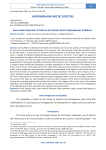
Socio-Labor Potential of Youth in the Russian Arctic: Reproduction Problems
Статья научная
Active efforts to develop the elements of territorial socio-economic systems of the Russian Arctic are the key to the efficient development of its resources. One such element is the labor potential, which, on the one hand, is a social factor of territorial self-development in the Russian Arctic, and, on the other hand, is capable of effectively implementing national interests in the Arctic. In this regard, the quality of labor potential of the regions of the Arctic zone of Russia is of particular relevance, which is the focus of the author’s research. The first two stages of the study identified labor potential as a social factor in the self-development of the regions and local communities of the Russian Arctic, and also analyzed child poverty as a systemic factor limiting the possibilities of quality reproduction of labor potential of the regions of the Arctic zone of Russia. The purpose of the next stage of the study, the results of which are presented in this article, was to analyze the socio-economic situation of young people in the regions of the Russian Arctic as part of the formation of qualitative characteristics of labor potential of the Arctic zone of Russia. The research methods include statistical analysis of socio-economic situation of youth in the regions of the Russian Arctic and analysis of normative legal documents regulating certain issues of socio-labor relations. In the course of the study the main problems of socio-economic situation of the youth in the Russian Arctic, limiting the promising opportunities of their life activity in the regions of the Arctic zone of the Russian Federation, were identified. The results of the study are focused on their practical use in the management of the development of labor potential of the regions of the Russian Arctic.
Бесплатно
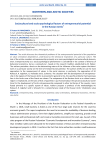
Sociocultural and socio-psychological factors of entrepreneurial potential in the Russian Arctic
Статья научная
The article discusses the theoretical problems of the entrepreneurial potential of the population on value orientations dependence, understood as the behavioral imperatives of a particular culture. The text of the article considers entrepreneurship primarily as a socio-psychological and sociocultural phenom-enon. Entrepreneurship as a socio-psychological phenomenon is considered in the context of theories of behavioral economics, but as a sociocultural - based on the research tradition established by M. Weber. The authors postulate a thesis on the determining nature of the influence of the value system that domi-nates in a particular society on the level of entrepreneurial potential. The authors briefly set out the main approaches to the measurement of values in the social sciences, in particular, the approaches of M. Rokeach, R. Inglehart, G. Hofstede and S. Schwartz. The situation with the development of entrepreneur-ship in the regions of the Russian Arctic is presented in general terms, the specific problems that businesses face in the Arctic zone of the Russia are shown. The uniqueness of the Russian Arctic as a cultural macro-region is emphasized, on the basis of that a hypothesis is put forward about the special sociocultural condi-tions for the development of Arctic entrepreneurship compared to other territories of the country, mani-fested primarily in a specific system of values. Authors propose a synthesis of the methodologies M. Rokeach, R. Inglehart and S. Schwartz for a comprehensive study of the Russian Arctic' inhabitants value system.
Бесплатно
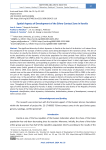
Spatial Aspects of Development of the Ethno-Contact Zone in Karelia
Статья научная
The significant diversity of ethnic dynamics in Karelia at the level of its districts is of interest from the standpoint of the concept of ethno-contact zones being developed in the national science. The aim of the study is to classify the districts of Karelia on the basis of the concept of ethno-contact zones according to the peculiarities of the dynamics of the titular population for three periods: from 1933 to 1959, from 1959 to 1989 and from 1989 to 2010. The article carried out approbation of the methodology of identifying the phases of development of ethno-contact zones at the intra-regional level. In total, eight types of ethnic dynamics have been identified, corresponding to positive or negative values in the change in the share of titular population (waves of titularization and detitulization) and four phases of development of ethno-contact zones (initial, growth of contact, beginning of dissolution and complete dissolution). In the period from 1933 to 1959, most districts of the republic entered the initial phase of dissolution of the ethno-contact zone on the wave of detitulization of the population. In the period from 1959 to 1989, in the northern part of the republic, there was a belt of districts, passing to the complete dissolution of the ethno-contact zone. In the period from 1989 to 2010, all eastern districts of Karelia and northern Ladoga were in the phase of complete dissolution of the ethno-contact zone. The districts in the western part of the republic retained the type of ethnic dynamics corresponding to the beginning of dissolution of the ethno-contact zone. Throughout all three periods, Olonetskiy district, located in the south of the republic, demonstrated a type of ethnic dynamics atypical for Karelia. In 2010, it remained the only district of the Republic of Karelia where the share of the titular ethnic group exceeded half of the population.
Бесплатно
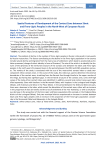
Статья научная
The problem of decline in the number of Finno-Ugric peoples in Russia is discussed in many works by Russian researchers. The factors contributing to the decline in the Finno-Ugric population in the country include natural decline and migration from the main areas of settlement, which leads to accelerated assimilation processes (change of ethnic identity in favor of Russians). The aim of the article is to identify the features of the dynamics of the territorial structure of the contact zone between the Slavic and Finno-Ugric peoples in the north-west of European Russia in the period between the 2010 and 2021 population censuses. The novelty of the study is associated with the use of the meta-ethnic contact index to study two-component ethno-contact zones. In the course of the study, this index was used to determine the external boundaries of the contact zone, stretching from the Barents Sea through Karelia to the upper reaches of the Volga, but having two significant gaps. In the territorial structure of the contact zone, cores with high values of the meta-ethnic contact index were identified. In addition, several local contact zones were identified separately: Slavs with Karelians in the Murmansk Oblast, with Vepsians in the Leningrad and Vologda Oblasts, with Estonians and Setos in the Pskov Oblast. In the period between the 2010 and 2021 censuses, there was a decrease in the index, which meant the dissolution of the contact zone, either with an increase in the proportion of Slavs (in Karelia and the area of settlement of the Tver Karelians), or with a simultaneous decrease in the proportion of the Finno-Ugric and Slavic populations (for example, in the Podporozhskiy district of the Leningrad Oblast). Only two municipal districts experienced an increase in contact between Slavic and Finno-Ugric peoples with an increase in the proportion of the Finno-Ugric population: Lovozerskiy in the Murmansk Oblast and Babaevskiy in the Vologda Oblast.
Бесплатно
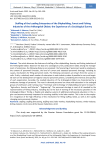
Статья научная
The article discusses the features of staffing of the shipbuilding, forestry and fishing industries of the Arkhangelsk Oblast. Based on the data of a sociological survey conducted in 2022 among the management of enterprises, the following features are analyzed: the forecasting of personnel needs by employers, the content of personnel forecasts, the level of current and expected personnel shortage, including its causes, mechanisms for filling personnel needs. The following conclusions are drawn from the survey results. Firstly, a relatively small number of enterprises in each industry makes it possible to carry out targeted work on the development of regional sectoral personnel policies, considering the interests and specifics of each organization. Secondly, the studied industries of the Arkhangelsk Oblast are characterized by a moderate shortage of personnel. The most in-demand personnel are those with education in the enlarged groups of professions and training areas “Technique and technology of shipbuilding and water transport”, “Agriculture, forestry and fisheries”, “Engineering”. The personnel shortage is most of all revealed by the representatives of fishing industry, including due to the lack of training of the necessary specialists in the Arkhangelsk Oblast. Thirdly, a flexible and adaptive system of additional professional education in the region can become extremely important for ensuring stability in the labor market. This is due to the employers’ recognition of the high efficiency of this mechanism for filling staffing needs, as well as the rapidly changing socio-economic situation.
Бесплатно
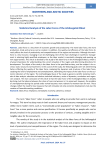
Statistical Analysis of the Labor Force of the Arkhangelsk Oblast
Статья научная
Labor force is a key driver of economic growth and productivity. The more labor force, the more production, trade and services can be created. In addition, the quality and efficiency of the labor force directly affects the level of productivity and competitiveness of the region and countries. Although the workforce is a key resource, managing it can be challenging. One of the main challenges in workforce management is retaining highly qualified employees, as the labor market is constantly changing and opening up new opportunities. This article is devoted to the study of the labor force in the Arkhangelsk Oblast, which is of great importance for understanding the current situation of the region and determining directions for development. The object of the study is the labor force in the specified territory, and the subject is its essence, state, structure and movement. In the course of the study, the following goals were set: determining factors affecting the quality of the labor force, analyzing the dynamics and structure of the labor force, studying the level of employment and unemployment, identifying the impact of the labor force on the economic indicators of the region. The methodological basis of the study is general scientific statistical methods of data analysis: absolute and relative statistical indicators, series of dynamics, correlation and regression analysis. The main conclusion of the article is that the labor force of the Arkhangelsk Oblast is steadily declining, but the balance between the share of men and women in it is preserved. However, the problem of unemployment during the period under review becomes more relevant for women than for men. These changes reflect the need for key measures that will stimulate not only economic development, but also the creation of favorable working conditions.
Бесплатно
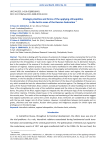
Статья научная
The article is dealing with the process of evolution of strategic priorities and practical forms of the realization of the ethnic policy in Russia on the example of the Arctic regions in the post-Soviet period. It is proved that the ethnopolitics of each Arctic region of the Russian Federation has its distinctive features, due to the complex of the reasons of its climatic, socio-economic, political and cultural nature. The differentiation of regional, national practices was more clearly manifested in the 1990s when in the Arctic regions, as well as in the whole country, the processes of sovereignty and politicization of ethnicity were observed. With the normalization of relations between the Federal center and regions, the separation of powers between the center and the entities of the Russian Federation at the turn of XX-XXI centuries, the Arctic regions are starting to build their ethnonational policy according to the strategic vision of the center. However, in the first decade of the XXI century, the ethnopolitics of the Arctic regions was more focused on the demonstration of ethnocultural diversity to the detriment of the ideas of consolidation of Russian society, which created the basis for ethnocultural mobilization and ethnic-egoism. The Strategy of the national policy of the Russian Federation 2012, contains conceptual foundations of nation-building and is biased in favor of the strengthening the unity of the multiethnic people and the state on the principles of civil solidarity. The policy of the Arctic regions begins to integrate into the all-Russian logic of the normalization of inter-ethnic relations. Ethnicity-related issues in the contemporary agenda are intimately connected with the security ones. The results of the sociological surveys and monitoring of the interethnic tensions suggest that regional authorities can control the current situation. Arctic territories are considered as the regions with the low and meager rate of ethnic tensions. However, contradictions between local people and migrants, old-timers and new settlers, Russian ethnic groups and indigenous peoples for similar rights and privileges are in the latent stage.
Бесплатно
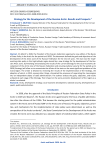
Strategy for the development of the Russian Arctic. Results and prospects
Статья научная
On March 5, 2020, the President of the Russian Federation approved a new edition of the Basics of State Policy in the Arctic for the period until 2035. The document defined the goals and objectives of the development of the Arctic zone of the Russian Federation for the next 15 years. The main tool for implementing state policy in this high-latitude region should be a new strategy for the development of the Russian Arctic zone. Summarizing and analyzing the results of the current Strategy for the socio-economic development of the Arctic zone of the Russian Federation and ensuring national security for the period up to 2020 (Strategy) will allow us to concentrate the efforts of the state on the most significant problems of the macroregion. The article is devoted to reviewing the results of the implementation of the Strategy, the adoption of which, in 2013, among other things, stimulated the processes of separating the macroregion into an independent object of state administration. The authors analyze the goals, objectives, and results achieved at each stage of the Strategy. Their impact on the socio-economic development of the region as a whole is evaluated.
Бесплатно
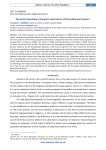
The Arctic population: dynamics and centers of the settlement system
Статья научная
The article presents an estimate of the Arctic population in 1900-2019 by country and macro-region, obtained using official statistics of eight Arctic States. Analysis of spatial and temporal data revealed the main patterns of the Arctic population formation. Calculations show the world’s Arctic population increased from 1.3 million in 1900 to 6.1 million in 1989, and then declined to 5.4 million in 2019. The share of Russia varied from 22% to 58%. The data show that interregional migration in the Russian Arctic had a decisive influence on the demographic dynamics of the Arctic in general. The main reasons for the decline in the Arctic population in different periods were the completion of cycles of natural resource development and lower quality of life in comparison with the central regions. To smooth out differences in national statistical accounting systems, the article examines the dynamics of the population in 17 major centers of settlement in the Arctic, where more than two-thirds of the population lives. Calculations show that urbanization and population concentration in several of the most attractive areas of the Arctic continue. Administrative and educational centers, which are points of attraction for residents of other Arctic territories, get an advantage. The results of the study allow us to predict the further evolution of the Arctic settlement system. They can be used in the development of strategies and programs for the spatial development of the North and the Arctic.
Бесплатно
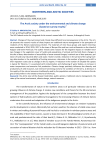
The Arctic society under the environmental and climate change (based on survey results)
Статья научная
Changes of the environment and climate have different local consequences in the Arctic. The article presents the research results of these impacts on traditional nature management in the perception of residents of the Nenets Autonomous District. The materials of nine focus groups and expert interviews were conducted in 2014, 2015, 2017 in the town of Naryan-Mar and two rural settlements on the island of Kolguev and Kanin Peninsula. The author reveals some reasons for the negative impact on reindeer herding: changes in the vegetation cover of tundra and populations of animals and the birds there; changes in the diet of deer; deterioration of accessibility of snow-covered forages; irrational use of deer pastures; pollution of tundra by industrial debris and waste. Hunters noted a reduction in the period of the spring hunting, deterioration in the availability of hunting resources, a decrease in the number of geese and a shift in their migration routes due to changes in the ice regime. A reduction in the number of valuable fish species is typical for fisheries. It is associated with contamination and shallowing of water bodies, an increase in water temperature and excessive fish production. Climate change positively influences the diversity and productivity of wild resources, but intensive harvesting worsens the condition of the berry. A decrease in the quality of the natural resources traditionally used by the population was observed. It increases the degree of discomfort in the remote territories of the Arctic.
Бесплатно
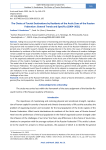
Статья научная
Taking into account the importance of maintaining and restoring physical and emotional strength, the need to reproduce human capital in harsh natural and climatic conditions of life, the problem of organizing tourism and recreation for the population of the the Arctic zone of the Russian Federation is an important area of scientific research. Despite the growing interest in the Arctic, the issues of choosing tourist destinations by residents of the Arctic regions and their change under the influence of modern challenges remain outside the scope of scientific research. This paper seeks to answer these important questions from the perspective of recreation in the Arctic. The aim of the study is to identify the general trends and specifics of the organized outbound tourism development in the Arctic zone of the Russian Federation under the influence of the modern challenges for the period 2004-2021 on the basis of the official statistical data. The model site of the study is nine Arctic Russian regions, fully and partially belonging to the Arctic zone of the Russian Federation. The study allowed assessing the dynamics, general trends and specifics of the development of outbound tourist flow of residents of the Arctic subjects in comparison with the average Russian indicators in the context of domestic and international tourism. It reveals changes in the volume of organized tourist flow, as well as its redistribution between tourist destinations under the influence of the challenges of our time.
Бесплатно
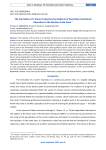
Статья научная
The purpose of the article is to identify the features of professional self-determination and formation of career trajectories of secondary vocational education students in the subjects of the Russian Arctic zone, their orientation towards professional implementation in the Arctic zone of Russia. The study is based on the survey of secondary vocational education students in the constituent entities of the Russian Arctic zone in the framework of the All-Russian career guidance lesson “Start your career in the Arctic and the Far East!”. A total of 686 questionnaires of respondents from Krasnoyarsk Krai, Murmansk Oblast, Komi Republic and the Republic of Sakha (Yakutia) were selected for analysis. The results of the study showed that only about a third of students have decided on further plans for building career trajectories. Most students, when shaping their professional future, are guided by personal desires and preferences, as well as by material well-being. Every tenth student does not clearly associate his/her future with employment in the specialty. About a third of students are focused on professional implementation in the Russian Arctic zone. The results of the study can be useful for researchers, specialists in professional self-determination, teachers and consultants of educational institutions of secondary vocational education, as well as authorities in the field of education, labor and employment.
Бесплатно
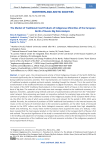
Статья научная
In recent years, the entrepreneurial activity of Small Indigenous Peoples of the North (SIPN) has increased significantly due to favorable economic climate through the development of programs of subsidizing traditional economic activities. Their representatives are involved in the production and promotion of traditional products on global and local markets, including through the Internet. This is the result of the transformation of the traditional lifestyle and adaptation to digital innovations. The study aimed to analyze the market of the SIPN’ traditional food products in the European North of Russia in the Internet on the basis of big data. The materials of the study were text messages related to the traditional economy of indigenous minorities, uploaded using methods and tools of automated data collection from the “VKontakte” social network. Data processing was based on innovative methods for analyzing large-scale data, the assortment of products of the traditional economy of the indigenous peoples of the European North of Russia, the offers for the sale of which were posted on the social network for the period in 2019-2022, were studied. Recently, the activation of producers of SIPN’ traditional food products in the Internet became the result, on the one hand, of restrictions due to the coronavirus pandemic, on the other hand, of increased interest to the SIPN’ culture and the Arctic biological resources, which provide their high adaptability, health and well-being. As a result, these northern products have acquired the status of a delicacy. It has been revealed that the most popular product on the Internet market in the European North of Russia is fish and seafood. The practical significance of the study is connected with the possibility of applying the results in the drafting and adjustment of strategic and program documents aimed at the development of the Arctic territories, preservation of the traditional way of life and economic activities of the indigenous peoples of the European North of Russia.
Бесплатно
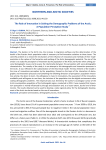
Статья научная
The decline in the birth rate, the increase in migration outflows and the deterioration of the health of the Russian Arctic population make it necessary to find innovative solutions to these issues. The scientific problem is to reveal the mechanisms of the influence of innovations and methods of their implementation in the sphere of the formation and realizing of the Arctic demographic potential. The aim of the article is to study the perception of innovation by the population of the Arctic territories when solving personal demographic issues and to assess the relationship between this perception with socio-demographic characteristics. The novelty of the study is in an attempt to link demographic and innovation processes in the Arctic. It was reflected in the substantiation of the theoretical model. The key element of the model is the zone of innovations perception by the population, formed on the basis of the interaction of demographic and innovation processes and combining the following directions of perception: population innovative activity, the desire to learn, the willingness to invest in innovations, the assessment of the innovations availability and willingness to use them, the inclusion of the population into the digital environment when solving demographic problems. The empirical basis was formed by the author's sociological survey of the Arctic municipalities population of the Arkhangelsk region, conducted in 2019. It was revealed that innovation perception is mainly influenced by the age and education and, to a lesser extent, by the level of their income. The results obtained can be used to develop a state regional policy for the demographic development of the Arctic territories based on the use of innovations.
Бесплатно
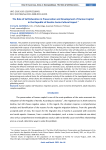
Статья научная
The problem of preserving human capital in the context of globalization is due to processes in the economic, social and cultural spheres. The search for a solution to this problem in the field of humanities is associated with aspects of personality self-development. Among the most important components of personality self-development, the majority of researchers in the humanities note self-education as a motivator for labor and social activity. Therefore, the identification of socio-cultural factors affecting the level and need for self-education requires a comprehensive interdisciplinary approach with regional specifics taken into account. Objective is to identify the factors influencing the level of self-education of residents in the modern economic and socio-cultural conditions of the Republic of Karelia. The material for cultural analysis was the results of field studies obtained during a scientific expedition to the Karelian Arctic, northern and southern border regions of Karelia. As a research methodology, an integrated cultural approach was used. Among the effective methods were focus groups on thematic cases, standard and non-standard questionnaires, interviews, polls, factor analysis, statistical and normative methods. For the first time in scientific practice possible sources, channels and preferences of the population of Karelia in self-educational activities have been researched. As a result, it was concluded that the combination of economic indicators is the determining socio-cultural factor for self-educational activity of the residents of the investigated areas and geographical indicator, which allows the inhabitants of Karelia to realize their spiritual and material needs at a high level and to preserve human capital as the main value of society in the unstable situation of a globalizing world.
Бесплатно
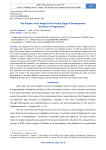
The Russian Arctic Image at the Present Stage of Development: Romance or Pragmatism?
Статья научная
The purpose of the article is to identify the characteristics of the Russian Arctic image at the present stage of its development in terms of a romantic and pragmatic context. In order to achieve this purpose, the content analysis of publications on the Arctic topic in the federal and regional media was carried out. A pilot sociological survey of the European part of the Russian Arctic zone residents was used as an additional research method. The study results showed that pragmatic orientation prevails in the “Arctic” content of modern media. The Arctic is presented in a positive way as a special priority territory of the country, the power and strength of the Arctic territories are emphasized, the images of the Arctic and their unique potential are revealed. In the population minds, the Arctic images are presented in a more romantic way — the associations of local residents are associated with the nature splendor, love for the North and beautiful winter. It is substantiated that the integrated development of the Arctic territories requires qualified personnel, not only filled with the romance of northern beauty, but also pursuing specific practical goals. The results of the study will be useful and interesting to specialists involved in the Arctic territories development, to executive bodies of state power, as well as to the general public.
Бесплатно
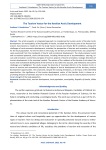
The Tourism Vector for the Karelian Arctic Development
Статья научная
The article presents an integrated approach to considering the tourism vector of Karelian Arctic development. Six municipalities of the Republic of Karelia, included into the Arctic zone of the Russian Federation, have become a model site for the study. Severe natural and climatic North conditions, along with challenges of socio-economic development, actualize the perspective of tourism and recreation, including for the local population. For the first time in the study, the territory of the Karelian Arctic was comprehensively examined from the standpoint of tourist and recreational development. The study analyzes tourist and recreational potential, tourist infrastructure, including infrastructure of accommodation, catering, leisure and recreation, tourist flow and types of tourism; projects of tourist orientation, strategic directions of tourism development in the municipal context. The opinion of the residents of the Karelian Arctic about the tourist and recreational development of the territory is also taken into account, and limitations and current challenges are highlighted. The study reveals the diversity of municipal districts in the Karelian Arctic in terms of tourism and recreational potential, the degree of tourist development of the territory, tourism development opportunities, the constraints. Despite the existing limitations, on the basis of the identified opportunities, the significance of the tourism development vector of the Karelian Arctic is shown as a promising direction of domestic tourism in the Russian North, as well as a tool to restore physical and emotional strength of the local population.
Бесплатно
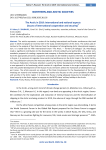
Статья научная
The article represents a review of the leading international and Russian conferences that took place in 2019 and played an essential role in the study and development of the Arctic. The author paid attention to the analysis of their features from the standpoint of strengthening Arctic international cooperation. It is noted that the Fifth International Forum “The Arctic - Territory of Dialogue” (St. Petersburg) made a significant contribution to the development of Arctic solidarity and partnership. The author commended a proposal of creating a separate state company in Russia that would operate on the Arctic shelf, have the appropriate personnel, equipment and would not be related to business interests. It is noted that in Russia, it is necessary to organize more events and conferences on the Arctic topic in the Arctic territories. The publication concerns the measures taken by the country's leadership to manage the Arctic zone of the Russian Federation. Particular attention is paid to the further development of the Northern Sea Route, a new approach to its functioning, which consists of a significant increase in its cargo transportation along with the parallel development of the Russian Arctic territories within the framework of development support zones. The article presents an analysis of the State Commission for the Development of the Arctic meetings on research and national projects. The author also focuses on the current problems of defense and security in the Arctic region. It is noted that Russia is taking adequate measures to strengthen its national security in the Arctic region in response to the NATO states' military buildup in the Arctic.
Бесплатно
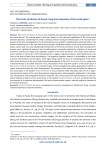
The long-term dynamics of the social space of the Russian Arctic
Статья научная
The Russian Arctic was explored and populated rigorously and purposefully during the Soviet period. The settling pattern was then based on the industrial capabilities of the Arctic areas (mineral deposits), considering the need to develop relevant transport infrastructure. The incentive component of the Soviet propaganda of Arctic development was aimed at mobilizing the skilled workforce. The market transformation in the late 20th century caused a rapid deterioration in the social and economic situation nation-wide: the state abandoned protectionism of the Arctic territories so that state-provided preferences were significantly reduced. Such transformations eventually entailed the reduction of social and economic services and a large-scale migration outflow in the Arctic territories. The current social and economic situation in the Arctic is still characterized by a negative migration balance, which determines a decline in the level of labor force participation. The negative migration balance is attributable to the lower economic attractiveness of the region, which again brings about the issue of unemployment in the Arctic. Destructive processes in the social and economic development of the Russian Arctic shape multi-faceted threats to its stable evolution. Thus, the analysis of the long-term pattern of the social space in the Russian Arctic is an essential aspect of new emerging conceptual approaches towards research and practical plan for Arctic development. The purpose of the survey was to review the pattern of the social space in the modern Russian Arctic territories between 1950 and 2018, with one of its objectives being the analysis of its social development stages based on historiographic, problematic / chronological, retrospective and comparative-historical methods. The survey shows that transformations in the consistent long-term pattern of the social space in the modern Russian Arctic are determined by the intensity of its industrial development, the scale of government support, and the long-term interests of the national economy.
Бесплатно

The observatory of Finno-Ugric indigenous peoples in the Republic of Karelia
Статья научная
The article deals with the potential rights implementation assessment for the Karelians, the Vepsians, and the Finns - indigenous minorities and ethnic (national) minorities in the Republic of Karelia. The purpose of the article is to form an observational passport of the indigenous small-numbered peoples of the Republic of Karelia (i.e., the Vepsians, the Karelians, and the Finns), which would record the varying degrees of satisfaction of the indigenous small-numbered population of the Republic with the results of the policy pursued. The subject of this article is the peculiarities of the potential rights implementation Karelians, Vepsians, and Finns - indigenous peoples and ethnic (national) minorities of Karelia. As part of the study, a tool was developed to assess the potential rights implementation in the Republic of Karelia - an observational passport of indigenous peoples. The presented material is based on the results of a survey organized in the fall of 2017 in all municipalities of the Republic of Karelia. The authors substantiate the differentiation of potential rights implementation of the indigenous peoples of the Republic in 4 sectors (economic, social, cultural, and religious), according to 3 levels (low, medium, and high). It was found that the low potential rights implementation in almost every sector of the study is typical of the Vepsians, the Karelians, and the Finns are generally characterized by the potential rights implementation of the average level.
Бесплатно

